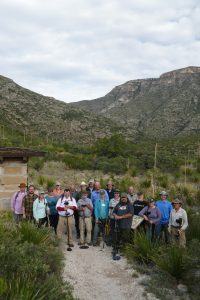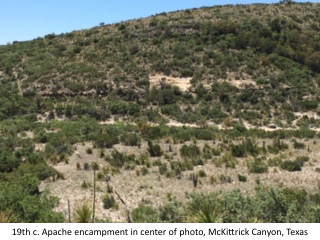Fourteenth AMDA Class: Carlsbad, New Mexico and Guadalupe Mountains NationalPark, Texas
From September 20 through 22, 2019, AMDA conducted its fourteenth class designed to train professional archaeologists in the best practices of systematic metal detection. The first day of classroom training took place at the Bureau of Land Management-Carlsbad, New Mexico Field Office. Seventeen individuals registered for this class, including archaeologists from federal agencies (BLM, NPS, USAF), universities (Sul Ross University-Alpine, Texas; Flinders University-Adelaide, Australia), and private sector environmental companies (SWCA, SRI, Mergent, Inc., P&C Scientific, Versar, AES Alaska, Keller Schroeder). Three AMDA instructors gave presentations regarding the history of metal detection; basic survey and artifact retrieval techniques in the use of metal detectors; guidelines for planning a metal detection project; and types of metal detection surveys. Instructors also imparted their knowledge regarding the identification of Apache-related artifacts (both metallic and non-metallic), and intra-site features typically associated with Apache encampments in the Desert Southwest. By doing so, class attendees were better prepared to participate in the two-day field exercise that involved the metal detection survey of a 19th-century Apache encampment (41CU466).

41CU466 is located within McKittrick Canyon, Guadalupe Mountains National Park. For over three centuries the Mescalero Apaches occupied the Guadalupe Mountains, which provided them a natural defensive stronghold within secluded drainages and canyons. Their security was challenged during November-December 1869, when a cavalry unit attacked and destroyed three Apache encampments (rancherías) located within this mountain range. Results of a 1997, reconnaissance-level metal detection survey of 41CU466 produced artifacts that suggested this is the locality of one of the rancherías attacked by the cavalry unit. A more intensive metal detection survey by the AMDA class was designed to determine the area extent and internal complexity of 41CU466, thereby providing the park with information needed to interpret and protect this important site. Guadalupe Mountains NP also consulted with the Mescalero Apache Tribe regarding this AMDA project. Accordingly, the Mescalero Apache Tribe Historic Preservation Officer (THPO), accompanied by a Tribal elder, visited the site during the metal detection survey. The THPO participated in the survey, and the Tribal elder imparted information regarding the life ways of his ancestors when they occupied the Guadalupe Mountains over 150 years ago.
The students were introduced to various metal detector makes and models including very low frequency (VLF) and pulse induction (PI) machines; became familiar with the efficacy of using hand-held pin pointers; and mastered excavation techniques typically used in metal detection. Several students also learned how to use the Trimble® GNSS hand-held receiver, which provided sub-meter accuracy in determining the exact location of each artifact.

The two-day survey resulted in the recovery of 111 artifacts over an estimated three-acre area. Several artifacts are reflective of the cavalry unit’s armaments and tactics. Other artifact types indicate the armaments and tactics used by Apache warriors when they defended their encampment during the cavalry attack. Recovered domestic-related artifacts include glass scrapers, iron awls, segments of barrel hoop intended for making arrow points, brass jingles, an ear cuff made from a cartridge case, and Mexican bridle parts. As a result of this survey, Guadalupe Mountains NP will initiate a metal detection survey project designed to identify other Apache encampments that are located within this mountain range.
